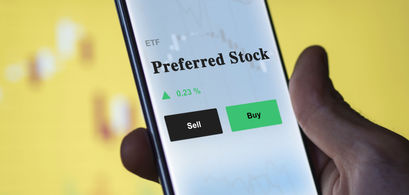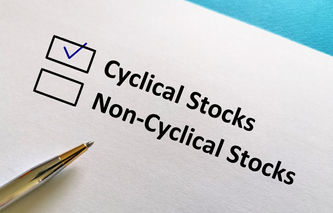When investors talk about buying stocks, they're typically referring to shares of common stock. But preferred stock offers the investor the advantages of both common stock and bonds, and is oftentimes a compromise worth pursuing. In terms of financing, preferred stock usually occupies a relatively small percentage of the overall mix of a company's capitalization; typically accounting for less than 10% of a company's overall source of funds. That's because from a tax standpoint, preferred stock is treated as equity, but the requirements for dividends are more like bond payments.
Preferred Stock
Since preferred stock is considered an equity security, the dividends paid are taken on an after-tax basis, just like common stock. If the company were to issue bonds instead of preferred stock, then the interest expense on the bonds serves to reduce the company's tax liability; since it's tax deductible. The amount of dividends paid on preferred stock is usually fixed. This means as long as a company is not on the verge of bankruptcy, they will be paying dividends on their preferred shares on a regular basis. This feature of preferred stocks provides investors with a reliable source of income. Most companies treat the payment of preferred stock dividends like their bond payments. Unfortunately, these payments are not tax deductible, like the interest expense on a bond. So why would a company bother issuing preferred stock?
Utilities Issuing Preferred Shares
There are many interesting niches that preferred stocks can fill, and perhaps the most interesting has to do with the utility industry. Most electric and gas utilities go through a rate-setting process that involves constructing a cost-of-service study. Without getting into the details of how rates are set, there is one nuance about this process that makes preferred stock very attractive to utilities. Specifically, preferred stock dividends are treated like an expense for rate-making purposes.
As the name implies, preferred stocks may carry certain features such as payment preference, convertibility, and callabilityMoneyzine Editor
That means utilities can pass on the cost of the dividend payment in the rates they charge their customers. Under these conditions, dividends on preferred stock act very much like interest expense on debt. This also means preferred stock is used more in the utility sector than anywhere else.
Characteristics of Preferred Stock
The name "preferred stock" is by no means an accident. This class of stock has characteristics that are "preferred" over common stock. The following is a list of the most common characteristics, which serves as a proxy for a preferred stock definition:
Payment Preference: dividends on preferred shares are always paid before those associated with common stock.
Assets: in the event of bankruptcy or liquidation, preferred stockholders are subordinate to bondholders, but would be paid before common stockholders.
Convertibility: provides the holder with the right to convert to shares of common stock.
Non-Voting: preferred shareholders are usually excluded from voting on matters such as the board of director elections.
Callable: unlike common stock, preferred shares can sometimes be called, or redeemed, at a future point in time. This is often after a predetermined date, and at the discretion of the issuing company.
Features
Some of the characteristics of preferred stock feed right into a discussion of their features. These characteristics enable companies to include features that add to the marketability, and flexibility of these securities as demonstrated below.
Callable / Redeemable
A preferred stock is said to be callable, or redeemable, when the issuing company has a right to redeem the outstanding shares. This is a common feature and gives the issuing company the ability to use these shares for a specific funding purpose. The price at which the stock is callable is usually stated in terms of its par value.
Convertible
Holders of preferred stock are sometimes offered the option of converting their shares into common stock at a predetermined ratio. This convertible feature is attractive to shareholders because they are entitled to the steady stream of dividends, plus they can enjoy appreciation in value if the price of the company's common stock rises.
Participating
When a security is described as participating, shareholders participate in the dividends of common shareholders. Participation is usually done at a predetermined rate. For example, if a 7% preferred stock is said to be fully participating, then not only does the shareholder receive a 7% dividend, but they fully participate in any dividend paid to holders of common stock.
Cumulative
The final feature is the cumulative characteristic. If a company fails to pay its dividend to preferred stockholders, then it must make up that dividend in future years before payments can be made to common shareholders. Nearly all preferred securities have this feature for obvious reasons. If a company could to pass on its preferred dividend each year, the investment would quickly lose its marketability. Stated another way, investors often purchase this security for the dividend; if paying it were optional, the investment loses its value.
Stock Quotes
We have published an entire article dedicated to reading Stock Tickers and Ticker Symbols. Anyone thinking about buying preferred stock will find a table at the end of that article describing how to identify, and find, preferred quotations. Here's an example of how this works. Let's say an investor were to find a quotation for PSEG's (a utility) preferred stock, the symbol might read like this PEGPRA. This symbol is translated as PEG (PSEG), P (preferred stock), R (voting Rights), Class A preferred stock.
Quality Ratings
There is no preferred stock rating system like what's available with bond ratings. But when evaluating a preferred stock, there are some simple rules to keep in mind before committing to any purchase. Investing in preferred stock is like a combination of stock and bond investing. That means it's necessary to understand if the company is financially healthy, and how it stands with respect to cash. Investors need to be sure the company has enough resources to pay its dividends. To get a good feel for a company's ability to make dividend payments, look at the company's financial ratios. We've written extensively on this topic and one of the important metrics to consider when buying preferred shares is the company's interest coverage ratio. Generally, the higher the interest coverage ratio, the better the chance they will make a dividend payment. Investors looking for a proxy for preferred stock ratings might want to consider using the bond rating system. Even though bond rating agencies use slightly different grading scales, a useful rule of thumb is that a company with a BBB / Baa rating or higher is considered investment grade.








